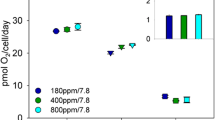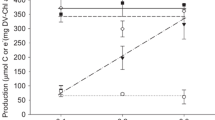Summary
Characteristics of inorganic carbon assimilation by photosynthesis in seawater were investigated in six species of the Fucales (five Fucaceae, one Cystoseiraceae) and four species of the Laminariales (three Laminariaceae, one Alariaceae) from Arbroath, Scotland. All of the algae tested could photosynthesise faster at high external pH values than the uncatalysed conversion of HCO -3 to CO2 can occur, i.e. can “use” external HCO -3 . They all had detectable extracellular carbonic anhydrase activity, suggesting that HCO -3 use could involve catalysis of external CO2 production, a view supported to some extent by experiments with an inhibitor of carbonic anhydrase. All of the algae tested had CO2 compensation concentrations at pH 8 which were lower than would be expected from diffusive entry of CO2 supplying RUBISCO as the initial carboxylase, consistent with the operation of energized entry of HCO -3 and / or CO2 acting as a “CO2 concentrating mechanism”. Quantitative differences among the algae examined were noted with respect to characteristics of inorganic C assimilation. The most obvious distinction was between the eulittoral Fucaceae, which are emersed for part of, or most of, the tidal cycle, and the other three families (Cystoseiraceae, Laminariaceae, Alariaceae) whose representatives are essentially continually submersed. The Fucaceae examined are able to photosynthesise at high pH values, and have lower CO2 compensation concentrations, and lower K1/2 values for inorganic C use in photosynthesis, at pH 8, than the other algae tested. Furthermore, the Fucaceae are essentially saturated with inorganic C for photosynthesis at the normal seawater concentration at pH 8 and 10°C. These characteristics are consistent with the dominant role of a “CO2 concentrating mechanism” in CO2 acquisition by these plants. Other species tested have characteristcs which suggest a less effective HCO -3 use and “CO2 concentrating mechanism”, with the Laminariaceae being the least effective; unlike the Fucaceae, photosynthesis by these algae is not saturated with inorganic C in normal seawater. Taxonomic and ecological implications of these results are considered in relation to related data in the literature.
Similar content being viewed by others

References
Axelsson L (1988) Change in pH as a measure of photosynthesis by marine macroalgae. Mar Biol 97:287–294
Axelsson L, Uusitalo J (1988) Carbon acquisition strategies for marine macroalgae. I. Utilization of proton exchanges visualized during photosynthesis in closed system. Mar Biol 97:295–300
Björkman O, Gauhl E, Nobs MA (1969) Comparative studies of Atriplex species with and without β-carboxylation photosynthesis and their first-generation hybrid. Yearbook of the Carnegie Institution of Washington 68:620–633
Brechignac F, Ranger C, Andre M, Dagnemet A, Massimino D (1987) Oxygen exchange in marine algae. In: Biggins J (ed) Progress in Photosynthesis Research, vol 3. Nijhoff, Dordrecht, pp 657–660
Brooks A, Farquhar GD (1985) Effect of temperature on the CO2/O2 specificity of ribulose-1,5-bisphosphate carboxylase/oxygenase and the rate of respiration in the light. Estimates from gas exchange measurements on spinach. Planta 165:397–406
Brown DL, Tregunna EB (1967) Inhibition of respiration during photosynthesis by some algae. Can J Bot 45:1135–1143
Cook CM, Lanaras T, Colman B (1986) Evidence for bicarbonate transport in species of red and brown macrophytic marine algae. J. Exp Bot 37:977–984
Cowan IR (1986) Economics of carbon fixation in higher plants. In: Givnish TJ (ed) On the economy of plant form and function. Cambridge University Press, New York, pp 133–170
Davison IR (1987) Adaptation of photosynthesis in Laminaria saccharina (Phaeophyta) to change in growth temperature. J Phycol 23:273–283
Davison IR, Davison JO (1987) The effect of growth temperature on enzyme activities in the brown alga Laminaria saccharina. Br Phycol J 22:77–87
Dromgoole FI (1978) The effect of pH and inorganic carbon on photosynthesis and dark respiration of Carpophyllum (Fucales, Phaeophyceae). Aquatic Bot 4:11–22
Graham D, Smillie RM (1976) Carbonate dehydratase in marine organisms of the Great Barrier Reef. Aust J Plant Physiol 3:113–119
Heath OVS, Orchard B (1957) Temperature effects on the minimum intercellular space carbon dioxide concentration. Nature 180:180–181
Holbrook GP, Beer S, Spencer E, Reiskind JB, Davis JS, Bowes G (1988) Photosynthesis in marine macroalgae: Evidence for carbon limitation. Can J Bot 66:577–582
Johnston AM, Raven JA (1986a) The utilization of bicarbonate ions by the macroalgae Ascophyllum nodosum (L.) Le Jolis. Plant Cell Envir 9:175–184
Johnston AM, Raven JA (1986b) The analysis of photosynthesis in air and water by Ascophyllum nodosum (L.) Le Jolis. Oecologia 69:288–295
Jolliffe EA, Tregunna EB (1970) Studies on HCO -3 ion during photosynthesis in benthic marine algae. Phycologia 9:293–303
Jordan DB, Ogren WC (1981) Species variation in the specificity of ribulose bisphosphate carboxylase-oxygenase. Nature 291:513–515
Jordan DB, Ogren WL (1984) Species variation in the specificity of ribulose bisphosphate carboxylase-oxygenase. Arch Biochem Biophys 227:425–433
Kerby NW, Raven JA (1985) Transport and fixation of inorganic carbon by marine algae. Adv Bot Res 11:71–123
MacFarlane JJ, Raven JA (1985) External and internal CO2 transport in Lemanea: interaction with the kinetics of ribulose bisphosphate carboxylase. J Exp Bot 36:610–622
Mehrback C, Culberson CH, Hawley JE, Pytkowicz RM (1973) Measurement of the apparent dissociation constant of carbonic acid in seawater at atmospheric pressure. Limnol Oceanogr 18:897–907
Miller AG, Colman B (1980) Active transport and accumulation of bicarbonate by a unicellular cyanobacterium. J Bacteriol 143:1253–1259
Park PK (1969) Oceanic CO2 system: An evaluation of ten methods of investigation. Limnol Oceanogr 14:179–186
Raven JA (1984) Energetics and transport in aquatic plants. MBI Lectures in Biology. Alan R Liss Inc, New York
Raven JA, Glidewell SM (1978) C4 characteristics of photosynthesis in the C3 alga Hydrodictyon africanum. Plant Cell Envir 1:185–197
Raven JA, Glidewell SM (1981) Processes limiting photosynthetic conductance. In: Johnson CB (ed) Physiological Processes Limiting Plant Productivity. Butterworths, London, pp 109–136
Raven JA, Samuelson G (1988) Ecophysiology of Fucus vesiculosus L. close to its northern limit in the Gulf of Bothnia. Bot Mar (in press)
Raven JA, Johnston AM, MacFarlane JJ, bin Surif M, McInroy S (1987) Diffusion and active transport of inorganic carbon species in freshwater and marine macroalgae. In: Biggins J (ed) Progress in Photosynthesis Research vol 4. Nijhoff, Dordrecht, pp 333–340
Riley JP, Skirrow G (1975) (eds) Chemical Oceanography vol 1. 2nd Edn. Academic Press New York
Sand-Jensen K, Gordon DM (1984) Differential ability of marine and freshwater macrophytes to utilize HCO -3 and CO2. Mar Biol 80:247–253
Seeley RR, Duncan MJ, Vidaver WE (1972) Preparative and analytical extraction of pigments from brown algae with dimethyl sulfoxide. Mar Biol 12:184–188
Skirrow G (1975) The dissolved gases-carbon dioxide. In: Riley JP, Skirrow G (eds) Chemical Oceanography vol 2. 2nd Edn, Academic Press, New York, pp 1–192
Thomas EA, Tregunna EB (1968) Bicarbonate ion assimilation in photosynthesis by Sargassum muticum. Can J Bot 46:411–415
Wheeler WN (1980) Effect of boundary layer transport on the fixation of carbon by the giant kelp Macrocystis pyrifera. Mar Biol 56:103–110
Wilbur KM, Anderson NG (1948) Electrometric and colorimetric determination of carbonic anhydrase. J Biol Chem 176:147–154
Author information
Authors and Affiliations
Rights and permissions
About this article
Cite this article
Surif, M.B., Raven, J.A. Exogenous inorganic carbon sources for photosynthesis in seawater by members of the Fucales and the Laminariales (Phaeophyta): ecological and taxonomic implications. Oecologia 78, 97–105 (1989). https://doi.org/10.1007/BF00377203
Received:
Issue Date:
DOI: https://doi.org/10.1007/BF00377203



